|
SP44
Copyright
2009-15 © Troels Gravesen
Discontinued from Jantzen Audio. Source components locally.
CABINET
FRONT
PANELS
CROSSOVER
CROSSOVER KIT
MEASUREMENTS
CROSSOVER
LAYOUT
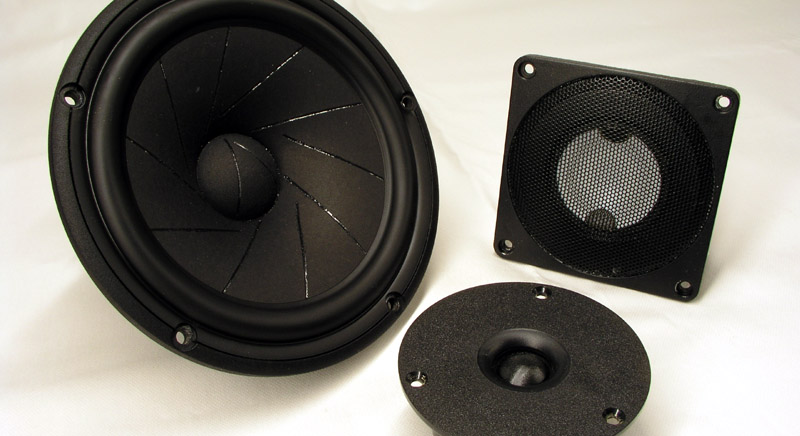
Click image to view large
View driver specs:
ScanSpeak
18W/8531-G00,
Accuton C244-8
(C50-8-044) ,
HIQUPHON OWI
The Accuton has a new name: C50-8-044 and from private
correspondence with Accuton, this is exactly the same driver.
I always
liked the SP38/13 and seeing the
large ScanSpeak D3806/8200 dome getting out of stock here
and there, John/US came in handy with a pair of Accuton C244-8 inverted
domes and a pair of HIQUPHON OWI tweeters as well, thus
the SP44 project was on track. We could also call it
Ekta-Accu, but SP44 it will be. Comparing SP44 to the
Ekta is obvious and despite not having them side by side,
I'm afraid the SP44 will beat the Ekta from a less
coloured upper mid/lower treble. These ceramic domes are
something special.
Now, what can the C44 do
the D3806 can't? Well, it goes deeper and it goes higher
and it has a remarkable flat response all up to 20 kHz
where a serious cone break-up occurs. 20 kHz is really
high and nothing to worry about in a 3-way system. The
C44 is not particularly sensitive, around 85-86 dB/2.8
volts - but all the same a good match to the 18W/8531
driver that usually can be tuned to a system sensitivity
of 86 dB/2.8 volts. Looking at C44 horizontal dispersion,
6 kHz seems like a good starting point for crossing over
to the tweeter, thus the C44 is really able to handle all
of the important treble range, because we can go
even lower compared to the D3806. From simulation 900 Hz
looks ideal, but no guarantee this will also sonically
make the best transition to the 18W midbass. Has to be
tried.
Last but not least, the C44 has the most clean cumulative
spectral decay I can remember, i.e. distortion is really
low.
The 18W/8531 and OWI drivers
are well known from numerous constructions, so not much
to add here. 8531 still one of the best 6-7" midbass available and the OWI is the 3/4" dome where
everything seems to have been done right!
We need some 28-32 liter
volume to please the 18W driver the best. From 32 liter
we get an F3 = 39 Hz. Not many 6-7" drivers can do
this. The price to pay is sensitivity being on the low
side. Vent tuning is a never ending topic and anything
from 28-38 Hz may do depending on taste. The higher we
go, the more response we get in the 50-100 Hz range,
where 28 Hz renders an almost flat response. 28 Hz is not
all that easy to achieve as we need a long port in a 32
liter net volume cabinet. 70 x 290 mm - or 60 x 210 mm,
the latter actually OK if we flare the vent to reduce
port noise.
So, why should you possibly try a
design like this?
1. Well, first of all enjoy the world of
diy loudspeakers and enjoy something you'll have to pay
at least 6,000-8,000 US $ for over the counter. Finished
speakers with the current set-up come with serious price
tags.
Mostly thanks to the C44, this speaker will merciless
tell you if you amps and musical sources are less than -
well, really good. I do not have a state of the art solid
state power amp, but my tweaked Rotel RB981 at least has
the power to make the 8531 bass drivers going. Do not run
this speaker on low-wattage anything. The 8531 bass
driver can go deep for the size like no other bass
driver, but it likes lots of amperes to perform its best.
I ran the SP44 from my 20 wpc AM amps and the sound is
great - much better than the 100 wpc Rotel, but bass grip is
lacking as soon as I crank up volume.
2. Next you may build this speaker because
you want deep bass from a small footprint and an overall
modest cabinet volume. The price to pay for this is low efficiency. Removing my
DTQWTs, having been on the stand for long, was a bit
shocking. Our livingroom seemed almost empty and going
from a total bass radiating area of something like 1850
cm^2 to a merely 300 cm^2 for the two 8531 drivers calls
for some mental preparation as well. I won't even try to
describe the difference in sound, but it is huge.
3. Last but not least: To try out the
ceramic drivers and hear what lack of colouration does to
your music.
Basic features:
3-way
~32 liter vented construction
System
sensitivity: 86 dB, 1 meter, 2.8 volts
Impedance: 8 Ohms, minimum
4 Ohms @ 400 Hz
Power handling: 60 watts (100h long term), and
please read this:
http://www.troelsgravesen.dk/power-handling.htm
Points of crossover: 900 and 5000 Hz, 4th order (LR4)
Amplifier
requirements: Minimum 20 watts - but all depends on how loud you
play. I would go with some 50 wpc minimum
Place speaker some
60-80 from front wall and not in corners. Also read this:
http://www.troelsgravesen.dk/Room-Acoustics.htm
Cabinet
BACK TO INDEX
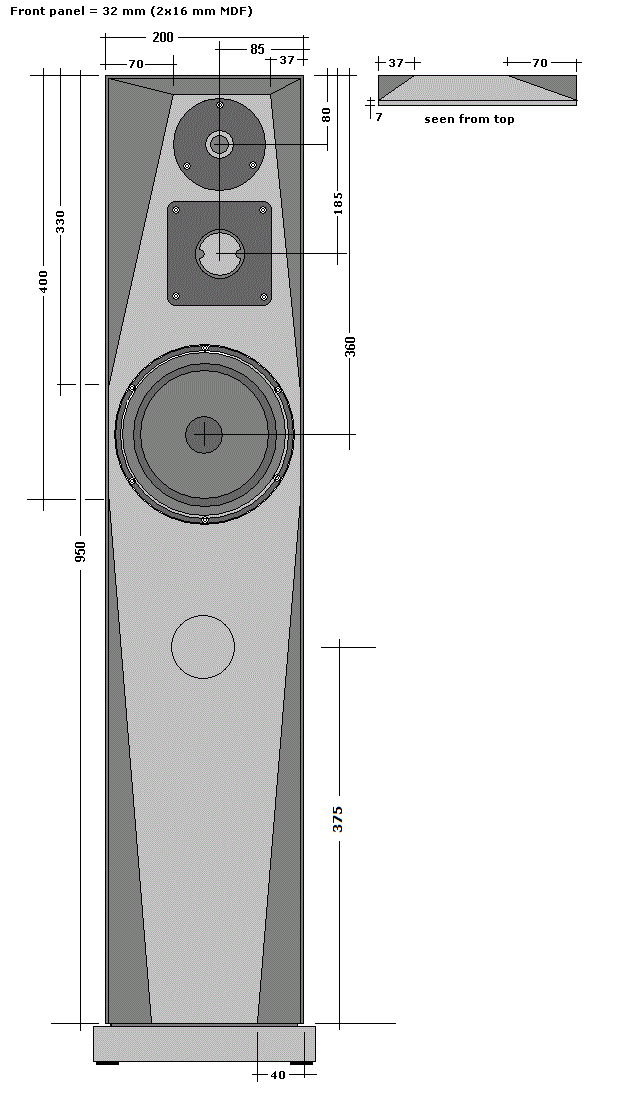
Cabinet dimensions: 200
(W) x 950 (H) x 280 (D)
Internal volume = 1.6 x 9.1 x 2.3 = 33.5 liter
minus bracing, vent and drivers.
Front panel = 32 mm = 2 x 16 mm
MDF.
Use 19-22 mm MDF or Baltic birch panels and add
bracing above and below 8531 driver. Check TJL2W for
construction details and how to dampen the
cabinet.
Use port 65 mm (ID) x 170 mm (L)
placed on rear panel at 450 mm height, or 70 mm
(ID) x 200 mm - or 60 (ID) x 140 mm to get a port
tuning of ~33 Hz.
Cabinet must be tilted 5 deg. to
render proper frequency response when listening
at tweeter height.
Do not forget to mirror
the front panels!
|
Cabinet damping:
Please read here general
advise on damping of a 24-32 litre floorstander:
http://www.troelsgravesen.dk/cabinet-damping.htm
FRONT
PANELS
BACK TO INDEX
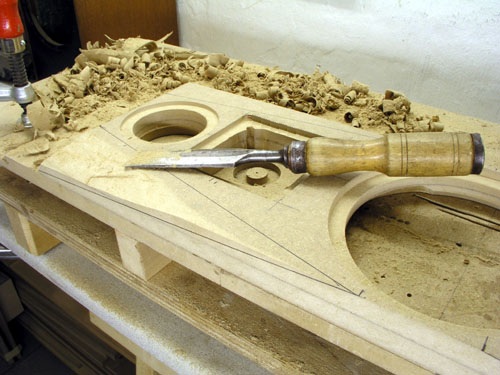 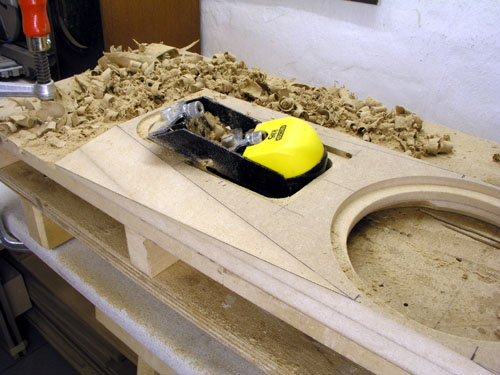
Facetting the front panels. Use 1) chisel, 2) planer and
3) sandpaper. Takes a few minutes from MDF.
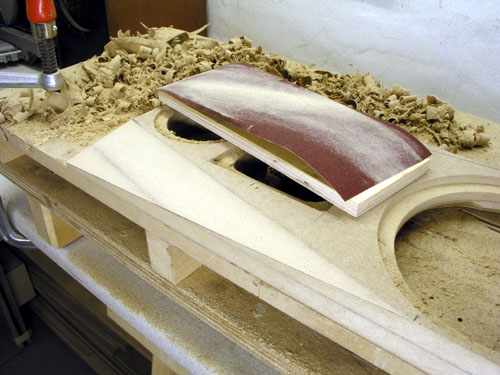 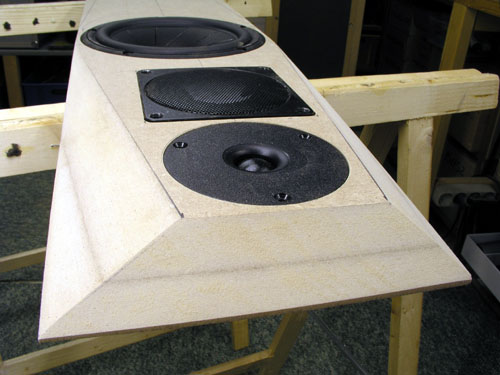
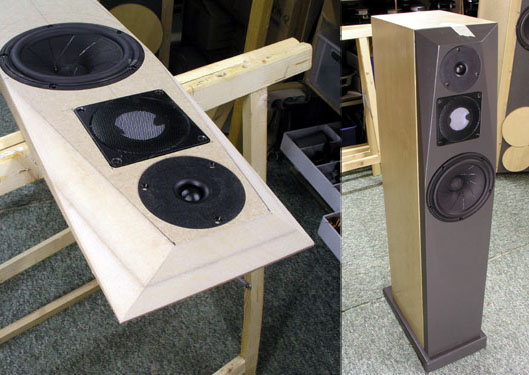 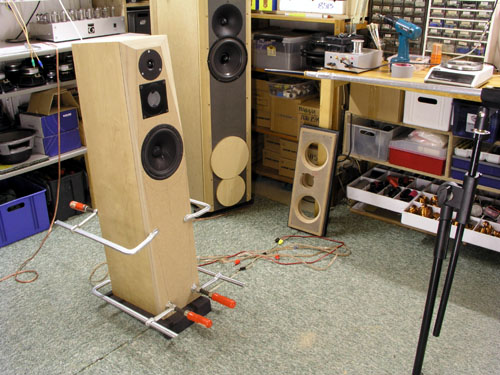
Right: Test set-up for initial measurements to generate
data files for LspCAD simulation.
Initial measurements
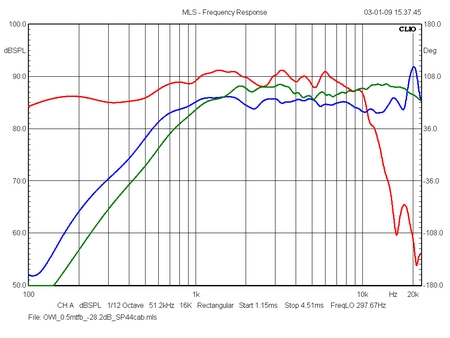 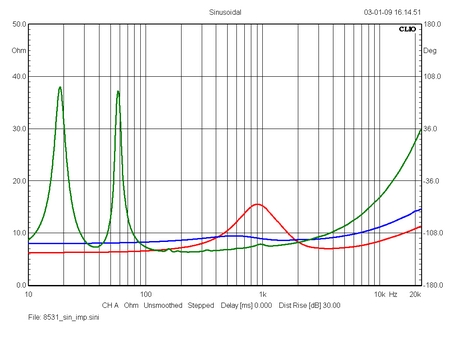
Left: SPL from drivers in cabinet, no crossover. Red =
8531, green = OWI, blue = C44.
Right: Impedance of drivers in cabinet. Red = OWI, blue =
C44, green = 8531.
C244-8/C50-8-044 driver
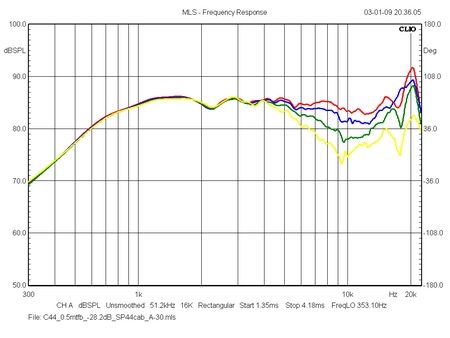 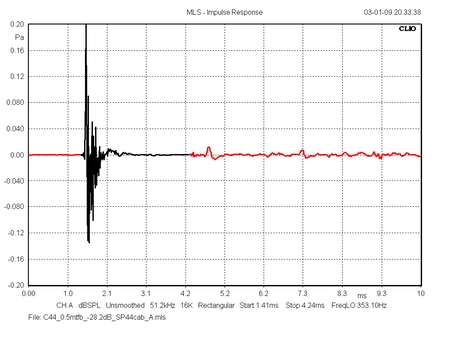
Left: Horizontal dispersion, 0-10-20-30
deg. Right: Impulse response.
Horizontal dispersion suggests point of crossover should
be placed around 6 kHz between mid and tweeter.
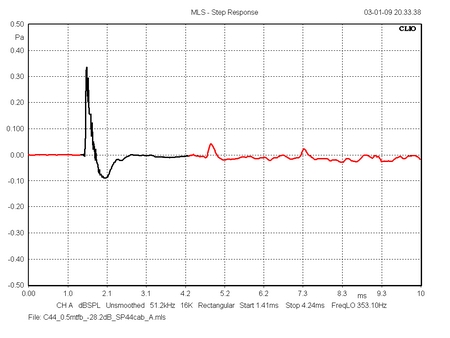 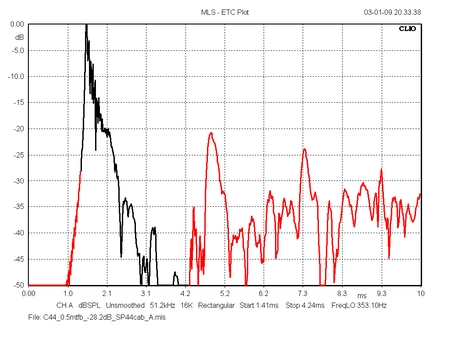
Left: Step response. Right: ETC Plot.
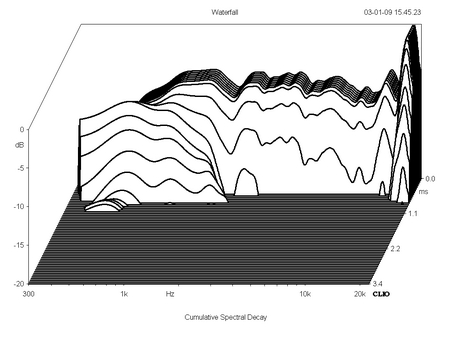 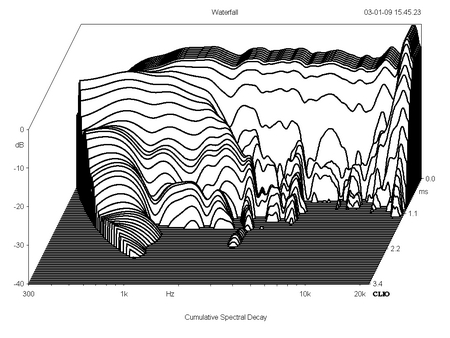
Cumulative Spectral Decay, C44 driver at 20 dB and 40 dB.
(I don't think I've seen anything this excellent before)
The Crossover - Simulation
version
#2 (#1 not shown)
BACK TO INDEX

Crossover version #1 for SP44.
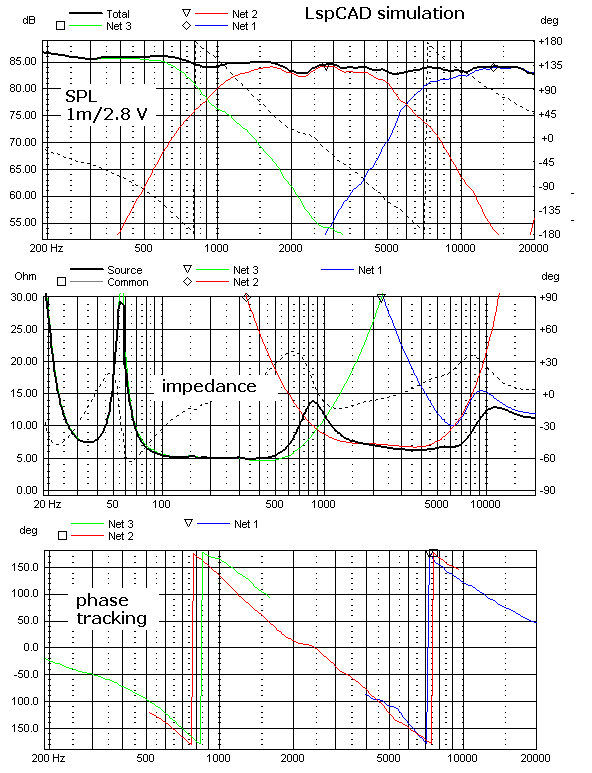
Measurements and crossover fine-tuning
BACK TO INDEX
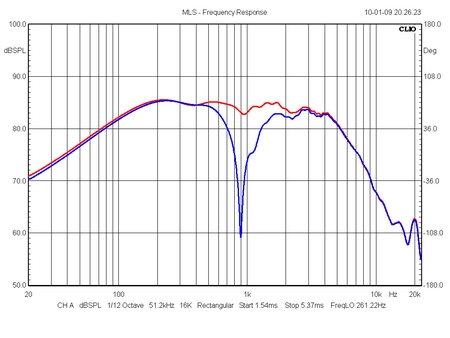 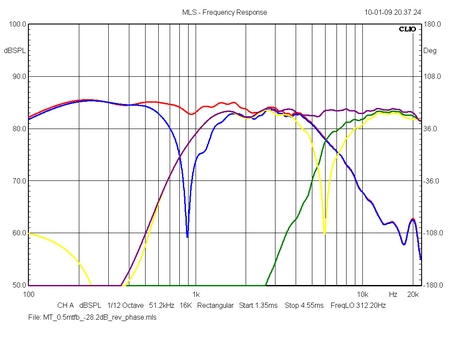
Left: After crossover assembly, the bass
and mid turned out pretty well and inverting mid polarity
produced the wanted deep suck-out, indicating point of
crossover around 900 Hz. All as predicted from LspCAD
simulation. The RC circuit across L2041 in the mid
crossover was omitted.
Right: The OWI is a quite capable driver, allowing fairly
low points of crossover, so it takes serious measures to
get it down at 6 kHz, thus a 4th order filter to make
proper summation and phase-traking. Inverting tweeter
polarity produced the wanted deep suck-out between mid
and tweeter (yellow). Now, this almost looks too easy,
but the trick here is to predict (measure) the acoustic
distance from drivers to the listening point before doing
the simulation. Based on measurements and experience, a
few millimeters have to added to the mid and bass
distance before starting simulation.
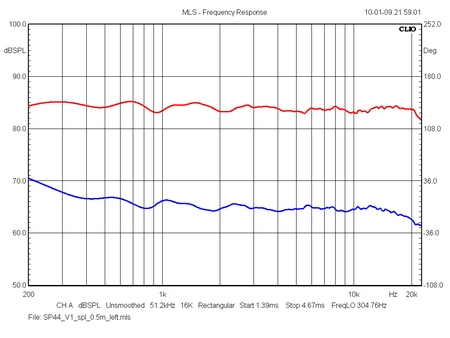 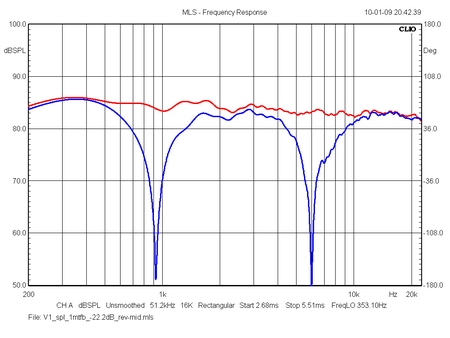
Left: Final response from crossover V1.
Blue = minimum phase. Rather flat I dare say. Not often I
tune a speaker this flat.
Right: The litmus test: Reverse mid polarity.
The suck-out at 6 kHz can really look like anything
depending on microphone placement, so this is only
show-off.
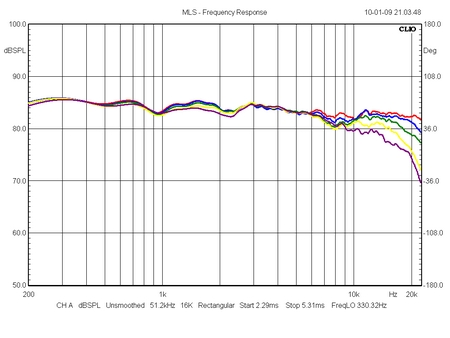 -10-20-30(B).jpg)
Left: Horizontal dispersion at 0, 10, 20,
30 mand 40 deg. An even power response up to 10 kHz is
seen over a very wide listening area.
Right: Vertical dispersion measured a 1 meter distance.
Red = 10 cm above tweeter. Blue = tweeter height. Green =
mid height. Yellow = between bass and mid. Purple = at
bass height.
Now, making a point of crossover at 6 kHz is calling for
trouble with regard to crossover lobing and this is no
exception. The good thing is that 6 kHz is really high
and not representative of what we actually hear, as our
two ears (fortunately) do not work the same way as a 5 mm
microphone capsule.
Crossover -
Simulation
version
#3
BACK TO INDEX
The sound from crossover version #2 was
indeed very promising. Lots of detail and transparency,
but also a distinct character from the C44 working up to
6 kHz. A sound very hard to describe. Not really
fullrange kind of sound, but slightly "cuppy",
i.e. like when you hold your hands around your mouth and
speak. This doesn't appear to be derived from a too high
upper mid level, rather limited dispersion, which is
strange as the horizontal dispersion is excellent. But
measurements are one thing, not always reflecting what we
aurally perceive. At 6 kHz we're close to where the C44
will start beaming due to the diameter of the cone and
maybe we're just pushing our luck from taking a 2"
dome this high.
Back to LspCAD, targetting 5 kHz point of crossover. What
appeared from this exercise was an almost perfect 4th
order LR crossover as can be seen from automatic
optimisation below. Not often this is possible.

Crossover version #3. Only L2041 was changed during
crossover optimisation from 0.68 mH to 0.56 mH to smooth
4-8 kHz range.
Mid and tweeter attenuation
Depending on your overall front end and
room acoustics, you may want to
balance upper mid and treble. I do not forsee you want to
decrease mid and
tweeter attenuation, but if you find the sound too
forward, try
2R7 or 3R3 to the mid and 5R6 or
6R8 to the tweeter.
The current tuning is rather flat and
you'll merciless be told how bad your - bad - CDs are.
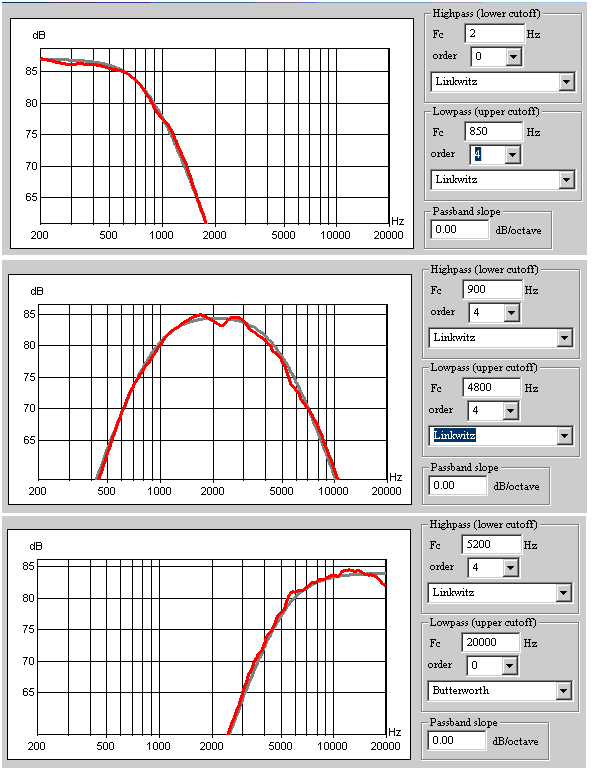
4th order LR crossover simulation. Points of crossover at
900 Hz and 5000 Hz.
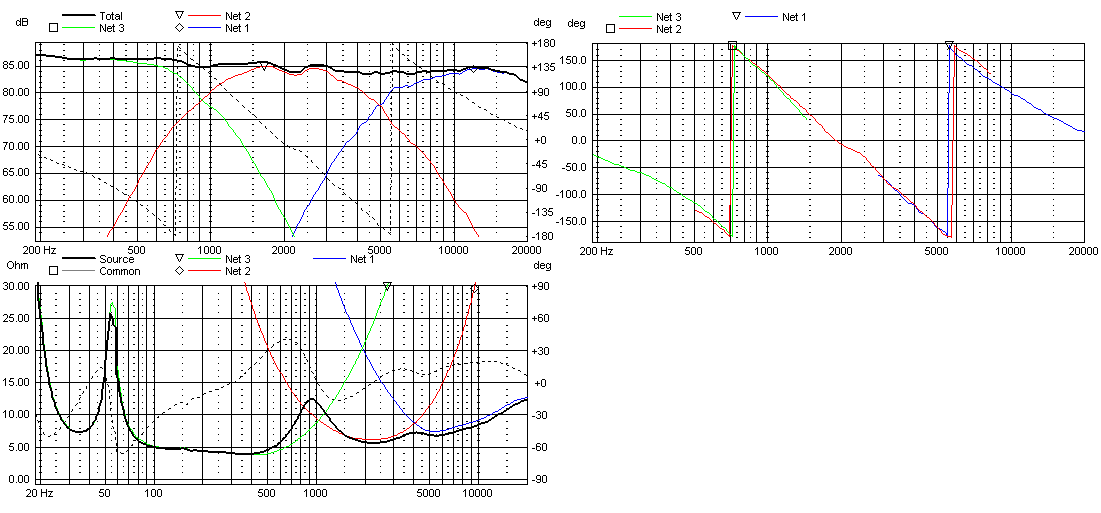
Upper left: Predicted response of drivers driven from
crossover and summed response (black).
Upper right: Phase tracking.
Lower left: Final system impedance. Minimum impedance = 4
ohms at 400 Hz.
Measurements on
crossover #3, 4th order LR
BACK TO INDEX
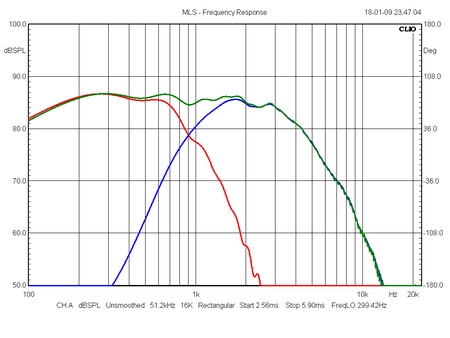
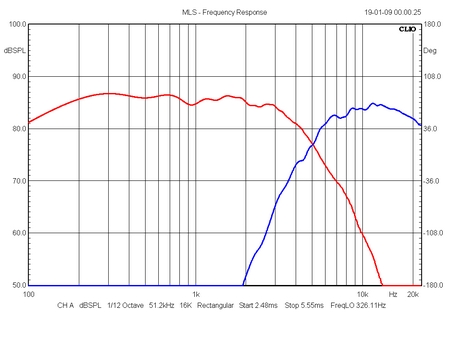
Left: Bass low-pass section and mid low-
and high-pass sections seems to be in place.
Right: Tweeter and mid appear to join hands at 5 kHz as
predicted.
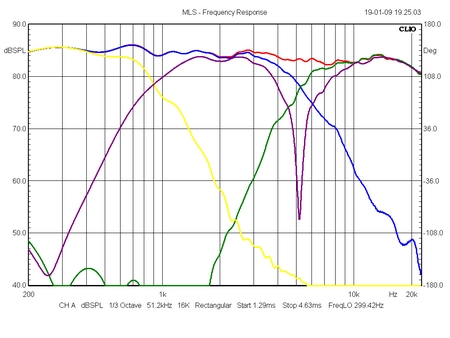 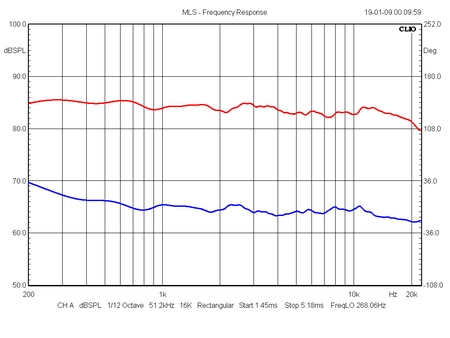
Left: Actual point of crossover between
mid and tweeter is 5200 Hz.
Right: Final response from V3 crossover. Blue = minimum
phase.
Now, this all seems pretty straight
forward, but how about the sound? Well, just what I had
hoped for. The slight cuppy sound from the inverted dome
is gone and after listening to a few vinyls and CDs, I
can't help feeling this is it! Very enjoyable indeed. The
8531 - as always - delivers firm and deep bass - that is,
if driven from not less than 100 watts solid state
amplifier. The upper mid/lower treble? Never heard it
better. These ceramic cones are something. Clean, clean,
clean. Treble? The HIQUPHON is totally cool in this
environment. Doing treble from 5 kHz is surely a piece of
cake for this magnificient tweeter.
Some comments on crossover components.
The drivers alone for this kit is a little above 1,000
EUR and if you plan to do the complete crossover from
standard polyprop capacitors, I suggest finding another
construction because you'll never render the full quality
of the C44 and HIQUPHON from less than the very best
components. The 22 uF and 68 uF caps in parallel with the
bass driver can be standard PP, but for the mid and
tweeter I suggest high-resolution super caps, i.e. caps
made from two series connected capacitors, e.g. Jantzen
Audio Superior Z-caps (~180 EUR), Mundorf MCAP Supreme
(285 EUR) or AUDYN-CAP Plus (160 EUR).
Use proper wound coils with non-ferrit core for the bass
driver. 1.2 mm wire gets DCR really low. Make sure the
coils are baked. For mid and tweeter, use air cored baked
coils, 1 mm wire for mid coils and 0.7-0.8 mm wire for
tweeter coils.
Crossover Kit
BACK TO INDEX
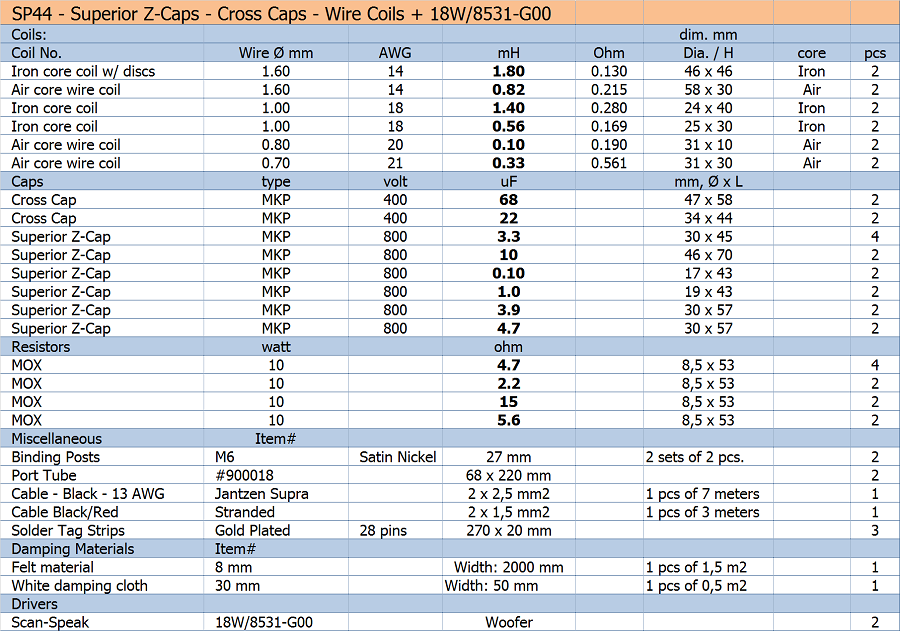
Discontinued from Jantzen Audio. Source components locally.
Buy HIQUPHON
directly from factory
here
(if you live in Europe)
Visit
website to find dealers
outside Europe.
No substitute for
OWI tweeter, sorry.
The Accuton C50-44-8 is available from
numerous sources, e.g.:
Lautspreachershop, DE
HiFiSound, DE (wrong
picture on website)
Falcon, UK
Madisound, US
Crossover layout:
BACK TO INDEX
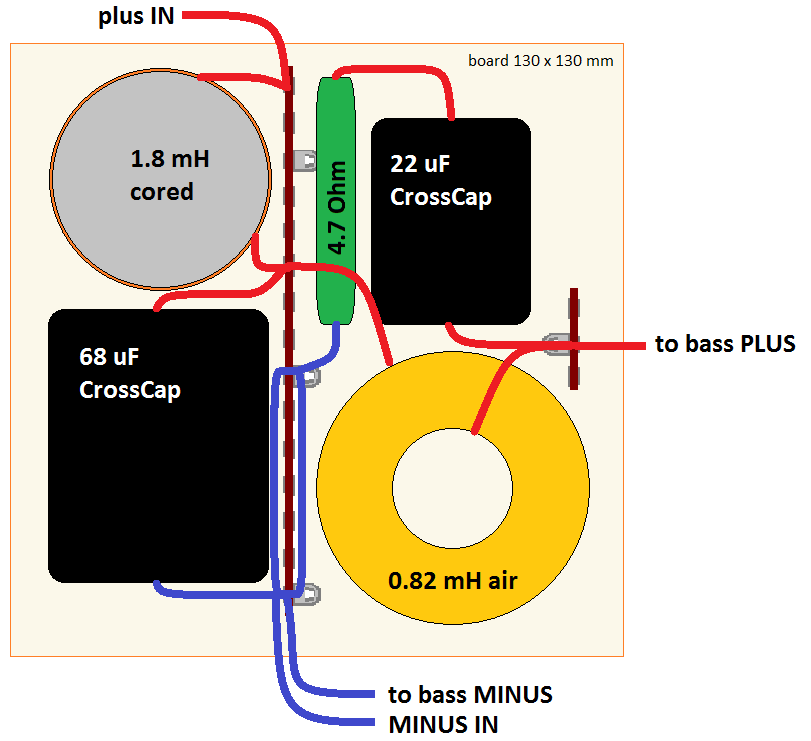
Bass low-pass section crossover layout.
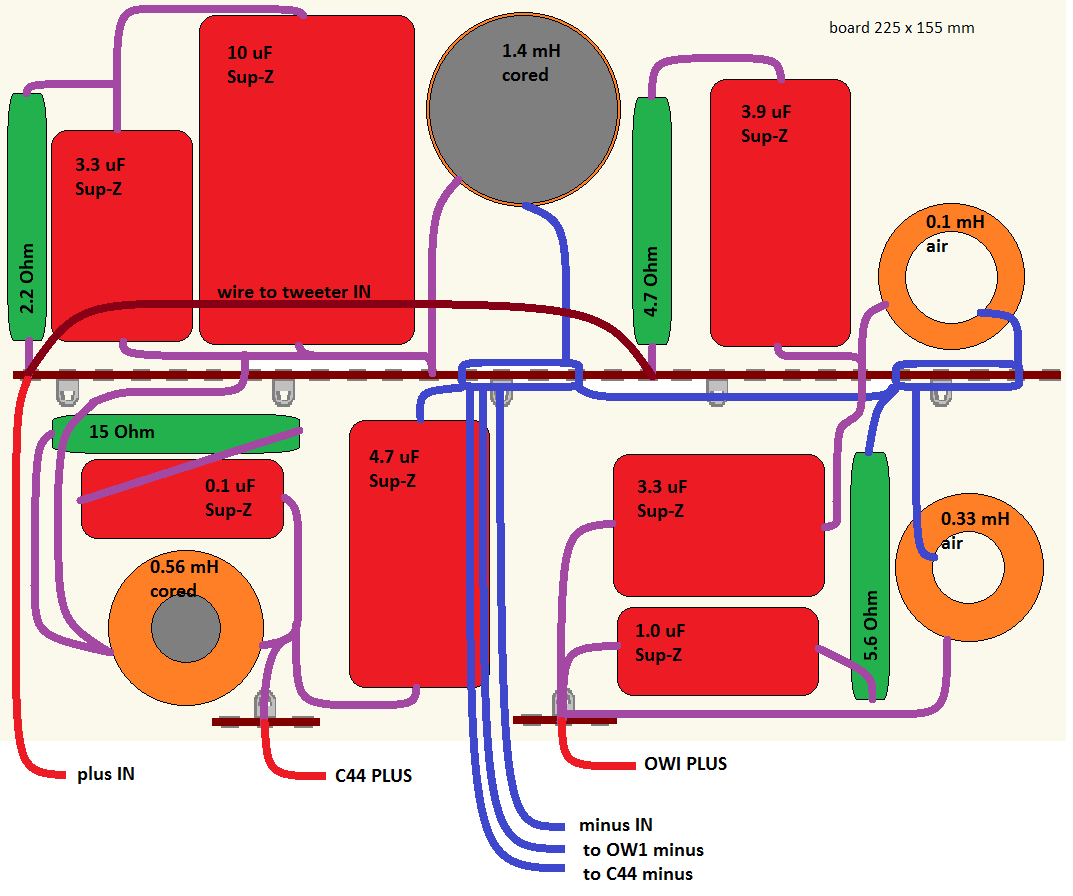
Mid and tweeter crossover section layout.
Layout is shown for Superior Z-cap version. This should
do for most super caps.
Standard PP caps may require a smaller board.
BACK TO INDEX
|




















-10-20-30(B).jpg)






